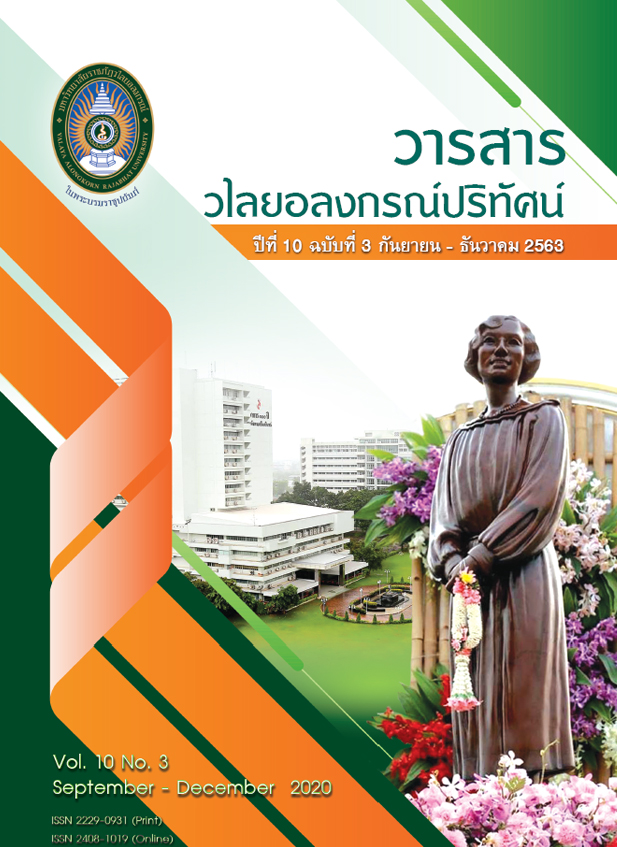มาตรการทางภาษีเพื่อการผังเมือง
คำสำคัญ:
มาตรการทางภาษี, การผังเมือง, การฟื้นฟูเมือง, การพัฒนาเมือง, ความเป็นเมืองบทคัดย่อ
ความเป็นเมือง คือ การเปลี่ยนแปลงสภาพแวดล้อมที่ถูกสร้างขึ้นจากการตั้งถิ่นฐานในชนบทให้กลายเป็นการตั้งถิ่นฐานในเมือง ในขณะเดียวกันก็ปรับเปลี่ยนการกระจายตัวของพื้นที่ จากพื้นที่ชนบทให้กลายเป็นพื้นที่เมือง ซึ่งการปรับเปลี่ยนสภาพแวดล้อมดังกล่าวถือปัจจัยที่สำคัญต่ออาชีพ วิถีชีวิต วัฒนธรรม และพฤติกรรมที่ทำให้เกิดการเปลี่ยนแปลงของจำนวนประชากรทั้งในเขตเมือง และในเขตชนบท โดยความเป็นเมืองนั้นจะขึ้นอยู่กับแนวทางการวางผังเมือง และการลงทุนของภาครัฐหรือภาคเอกชนในการจัดทำโครงสร้างพื้นฐานหรือการจัดทำบริการสาธารณะเป็นสำคัญ ปัจจุบันประชากรภายในเขตเมืองของโลกมีจำนวนเพิ่มขึ้นต่อเนื่อง ทำให้ปัญหาหลักของการผังเมือง ในประเทศไทยนอกเหนือจากขาดการบูรณาการระหว่างหน่วยงานของภาครัฐที่เกี่ยวข้องกับ การผังเมืองแล้ว ยังเกิดจากการขยายตัวของประชากรในเขตเมืองอย่างรวดเร็ว เนื่องจากการอพยพของแรงงานจำนวนมากเข้าสู่เขตเมืองชั้นใน ที่มีความเจริญกว่าเขตชนบท และมีอัตราการจ้างแรงงาน ที่มากกว่าในเขตชนบท ทำให้ขาดความสมดุลระหว่างแหล่งงานกับพื้นที่อยู่อาศัย ส่งผลต่อ การเปลี่ยนแปลงของขนาดครัวเรือนและโครงสร้างเศรษฐกิจ การขยายตัวของประชากรเมือง จึงไม่สอดคล้องกับการศึกษาปรับปรุงทางผังเมืองของภาครัฐที่ล่าช้า ก่อเกิดปัญหาทางการผังเมือง ทั้งด้านการใช้ประโยชน์ที่ดิน ด้านการสาธารณูปโภค การสาธารณูปการ และด้านการคมนาคมและการขนส่งที่เป็นปัญหาเรื้อรังมาอย่างยาวนาน ส่งผลให้เกิดภาระด้านการเงินแก่รัฐในการจัดทำโครงสร้างพื้นฐานต่าง ๆ เพื่อตอบสนองความต้องการของประชากรทั้งในระยะสั้นและระยะยาว มาตรการทางกฎหมายในเชิงที่เป็นมาตรการในการควบคุมทางการผังเมืองเพียงอย่างเดียวไม่อาจใช้บังคับให้เกิดการวางผังเมืองอย่างเป็นสากล ในประเทศไทยควรมีการใช้มาตรการทางภาษีในฐานะที่เป็นเครื่องมือทางเศรษฐศาสตร์ของภาครัฐส่งเสริมให้เกิดการปฏิบัติตามการผังเมืองควบคู่กันมาตรการทางกฎหมาย เพื่อให้บรรลุเป้าหมายตามเจตนารมณ์ของการผังเมืองในทุกมิติ ในต่างประเทศมีการจัดเก็บภาษีการผังเมือง (City Planning หรือ Town Planning Tax) เป็นภาษีที่ถูกจัดเก็บ อย่างมีวัตถุประสงค์พิเศษ (Earmarked Tax) สำหรับนำไปใช้จ่ายในการพัฒนาเมืองการบำรุงรักษาเมืองและค่าใช้จ่ายอื่น เพื่อยกระดับการพัฒนาเมืองให้ดียิ่งขึ้น โดยการจัดเก็บภาษี แบบแบ่งแยกตาม แต่ขนาดของเมือง และความเติบโตทางเศรษฐกิจของเมืองในอัตราที่แตกต่างกัน เพื่อสร้างรายได้ ในการจัดทำบริการสาธารณะแก่ภาครัฐในการพัฒนาหรือฟื้นฟูเมือง
เอกสารอ้างอิง
การเคหะแห่งชาติ. (2556). มองมุมเมือง. (พิมพ์ครั้งที่ 1). กรุงเทพฯ: การเคหะแห่งชาติ.
คำรบลักขิ์ สุรัสวดี. (2543). การศึกษาและการวิจัยเพื่อการชี้นำและกำหนดกรอบนโยบายการพัฒนาเมืองกรุงเทพมหานครและปริมณฑล กับการแก้ปัญหาจราจร. กรุงเทพฯ: จุฬาลงกรณ์มหาวิทยาลัย.
ฐาปนา บุณยประวิตร. (2556). การสนับสนุนทางการเงินเพื่อพัฒนาโครงสร้างพื้นฐานในพื้นที่พัฒนารอบสถานีขนส่งมวลชนของ สหรัฐอเมริกา (Infrastructure Financing Options for Transit-Oriented Development in USA.) แปลและเรียบเรียงจากรายงานเรื่อง Infrastructure Financing Options for Transit-Oriented Development ซึ่งเป็นรายงานเผยแพร่ของ Office of Sustainable Communities Smart Growth Program, U.S. Environmental Protection Agency จัดพิมพ์ในเดือนมกราคม 2556
พนิต ภู่จินดา. (2556). การผังเมืองกับการพัฒนาเมือง. (พิมพ์ครั้งที่ 1). กรุงเทพฯ: สถาบันพระปกเกล้า.
พระราชบัญญัติภาษีที่ดินและสิ่งปลูกสร้าง พ.ศ. 2562. (2562, 12 มีนาคม). ราชกิจจานุเบกษา ฉบับกฤษฎีกา เล่มที่ 136 ตอนที่ 30 ก.
สิทธิพล กุสุมอรัญญา. สำนักผังเมือง กรุงเทพมหานคร. แนวทางการส่งเสริมการพัฒนาในพื้นที่เขตกรุงเทพฯชั้นในและเขตกรุงเทพฯชั้นกลางให้เมืองกระชับ. [ออนไลน์], เข้าถึงได้จาก: http://cmc.bangkok .go.th/bmaitev/web/uploads/14.pdf. (2562, 22 พฤศจิกายน).
โสภณ พรโชคชัย. การเปลี่ยนแปลงราคาที่ดิน พ.ศ.2537-2561. (2562). [ออนไลน์], เข้าถึงได้จาก: https://www.area.co.th/thai/area_announce/area_press.php?strquey=press_announcement2913.htm. (2563, 20 มิถุนายน).
อภิวัฒน์ รัตนวราหะ. (2552). เครื่องมือการเงินเพื่อการฟื้นฟูเมือง. วารสารวิชาการ คณะสถาปัตยกรรมศาสตร์ จุฬาลงกรณ์มหาวิทยาลัย. เล่มที่ 2: 11.
อริสา จันทรบุญทา และ จิรัฐ เจนพึ่งพร. (2561). ความเป็นเมือง (Urbanization) และนัยเชิงนโยบายของไทย. FAQ Focus and Quick. Issue 128: 1-2.
Ernst & Young (EY). (2015). Megatrends 2015 Making sense of a world in motion. [Online], Available: https://www.ey.com/Publication/vwLUAssets/ey-megatrends-report-2015/$FILE/ey-megatrends-report-2015.pdf. (2020, 21 June).
Erwin Hepperle et al. (2017). Land Ownership and Land Use Development The Integration of Past, Present and Future in Spatial Planning and Land Management Policies. vdf Hochschulverlag AG, an der ETH Zurich.
french-property.com. Low Density Tax. [Online], Available: https://www.french-property.com/guides/france/building/planning/planning-taxes/. (2020, 10 June).
Frost and Sullivan. (2016). World’s Top Global Mega Trends To 2025 and Implications to Business, Society and Cultures. [Online], Available: https://www.thegeniusworks.com/wp-content/uploads/2016/01/Megatrends-2025-Frost-and-Sullivan.pdf. (2020, 21 June).
General Affairs Section, General Affairs Division Tokyo Metropolitan Government, Bureau of Taxation. (2019). Guide to Metropolitan Taxes 2019. (rev. ed.). Tokyo : Bureau of Taxation.
Japan International Cooperation Agency (JICA) and Ministry of Land, Infrastructure and Transport. (2007). Urban Planning System in Japan. (2nd ed.).
OECD. (2015). In It Together : Why Less Inequality Benefits All. [Online], Available: https://www.oecd.org/els/soc/OECD2015-In-It-Together-Chapter1-Overview-Inequality.pdf. (2020, 21 June).
Pierre Appremont. Town planning taxes. [Online], Available: http://www.fiscalimmo.com/index.php/en/home/th3-en/2014-04-03-14-35-26-en/113-article-1-modele-5. (2020, 5 August).
PWC. (2016). Five Megatrends And Their Implications for Global Defense & Security. [Online], Available: https://www.pwc.com/gx/en/government-public-services/assets/five-megatrends-implications.pdf. (2020, 21 June).
PWC China, Overview of PRC Taxation System. Major Taxes in the PRC. Tax on specific objective. [Online], Available: https://www.pwccn.com/en/services/tax/accounting-and-payroll/overview-of-prc-taxation-system.html. (2020, 20 March).
State Taxation Administration of the People’s Republic of China. Resources. Tax Type. [Online], Available: http://www.chinatax.gov.cn/eng/c101270/c101272/c5094513 /content.html. (2020, 20 March).
Thomas A. Gihring. (2007). Incentive Property Taxation. Journal of the American Planning Association: 64.
United Nations, Department of Economic and Social Affairs, Population Division. (2019). World Urbanization Prospects: The 2018 Revision (ST/ESA/SER.A/420). New York : United Nations.
United Nation, Department of Economic and Social Affairs. 68% of the world population projected to live in urban areas by 2050, says UN. (2018)[Online], Available: https://www.un.org/development/desa/en/news/population/2018-revision-of-world-urbanization-prospects.html. (2019, 10 December).
ดาวน์โหลด
เผยแพร่แล้ว
รูปแบบการอ้างอิง
ฉบับ
ประเภทบทความ
สัญญาอนุญาต
ข้อความที่ปรากฏในบทความแต่ละเรื่องในวารสารวไลยอลงกรณ์ปริทัศน์ เป็นความคิดเห็นของผู้นิพนธ์แต่ละท่าน มิใช่เป็นทัศนะและมิใช่ความรับผิดชอบของกองบรรณาธิการจัดทำวารสาร และ
มหาวิทยาลัยราชภัฏวไลยอลงกรณ์ ในพระบรมราชูปถัมภ์


